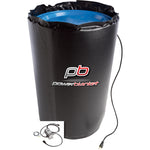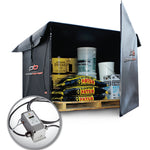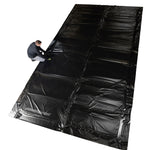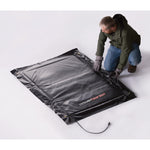You have no items in your shopping cart.
Concrete Curing Time Chart: Achieving Maximum Compressive Strength
Article At-a-Glance
What Is the Concrete Curing Time Chart and How Does It Guide Your Project?
The concrete curing time chart provides a quick-reference guide detailing how long concrete takes to cure under various conditions, showing that at ideal temperatures (55-90°F) and with wet curing, concrete can reach approximately 75% of its maximum strength in 7 days and 100% in 28 days, helping you effectively plan your construction or DIY projects.
Key Takeaways
- Understand Curing Stages: Concrete typically reaches 75% of its maximum strength in 7 days and 100% in 28 days under ideal conditions (55-90°F with wet curing).
- Temperature Impact: Hotter temperatures accelerate curing, while colder conditions slow it down, affecting the overall strength and durability of the concrete.
- Mix Design Influence: The water-cement ratio and use of admixtures can significantly alter curing times, with lower ratios requiring more careful curing to ensure complete hydration.
- Moisture Management: Preventing moisture loss is crucial; methods include wet curing and using curing compounds to maintain optimal hydration levels.
- Special Considerations: Adjust curing strategies for extreme weather, large pours, and structural elements to ensure the concrete achieves the desired strength and longevity.
Curing is vital for concrete to reach its full strength, as it allows the concrete to hydrate properly, forming microscopic crystals that bind everything together. The mix design, including water content and admixtures, affects curing time. Hotter temperatures can accelerate and strengthen curing, while cold temperatures slow it down. No matter what kind of climate you cure in, this article will help you know what you can do to get the strongest cure possible out of your concrete.

$1,915.99 USD
10’ x 10’ Multi-Duty Thawing & Concrete Curing Blanket (120V)
For a faster, more effective cure in cold weather, consider using a 10' x 10' multi-duty electric concrete curing blanket. Heat Authority provides superior performance by speeding up the curing process while ensuring optimal hydration levels, even in extreme conditions.
The Art of Concrete Curing: A Guide to Strength and Longevity
Concrete, the universal building material, may seem simple at first glance. However, achieving its full potential strength and durability relies heavily on a crucial process: curing. Curing is essentially creating an environment that allows the concrete to properly hydrate, the chemical reaction between cement and water that gives concrete its strength.
Imagine concrete as a network of microscopic crystals. During hydration, these crystals grow and fill the spaces between the cement particles, binding everything together. Improper curing disrupts this process, resulting in weak, brittle concrete prone to cracking and deterioration.
Temperature in Concrete Curing
Temperature plays a significant role in curing. Hotter temperatures accelerate hydration while colder weather concrete curing can slow it down.
- Exothermic heat of hydration: As concrete cures, it generates heat due to the chemical reaction. In large concrete pours, this internal heat can be significant and needs to be managed to prevent cracking.
- Prevent extremes: Ideally, concrete should cure in moderate temperatures (between 50°F and 70°F). Very hot weather can lead to rapid moisture loss and cracking, while cold weather can prevent proper hydration and increase the risk of freezing.
Concrete Mix Design Matters
The speed and completeness of curing also depend heavily on the concrete mix design. Here are two key factors in how mixture ingredients impact curing time:
- Water-cement ratio: This ratio directly impacts the amount of available water for hydration. A lower water-cement ratio leads to denser, stronger concrete, but also requires more attention to curing to ensure complete hydration.
- Admixtures: Certain admixtures can accelerate or slow the setting time of concrete, influencing the curing process. For instance, accelerators can be beneficial in cold weather to prevent freezing before adequate hydration, while retarders are useful in hot weather to slow down the curing process and prevent cracking.

The main benefit of using different mixes is that you can ensure a strong cure even if weather conditions are not normally suitable for pouring concrete.
Minimum Curing Times: Standards and Applications
It’s generally agreed upon that most concrete pours are safe for foot traffic 24-48 hours after initial pouring. However, additional weight such as equipment or vehicles shouldn’t be placed in concrete until several days have passed. The American Concrete Institute provides recommended curing times based on application and desired strength. While some projects may require longer cures, 7 days of proper curing is often sufficient for most applications to achieve 50% or more of the designed strength.
How Long Does 4 Inches of Concrete Take to Cure?
Unfortunately, there's no exact answer. The curing time depends on factors like the mix design, ambient temperature, and desired strength. That being said, four inches of concrete will cure faster than a thicker slab due to a higher surface area to volume ratio, allowing for faster moisture release.
Monitoring Moisture: The Key to Curing
Since proper hydration relies on available moisture, preventing moisture loss from the concrete surface is critical. Here are some methods:
- Wet Curing: This traditional method involves keeping the concrete surface saturated with water for a specified period. This can be achieved by covering the concrete with burlap and continuously wetting it, flooding the surface with water, or using ponding pads.
-
Using Curing Compounds: These create a moisture barrier on the concrete surface, reducing evaporation. They come in two main forms:
- Liquid membrane-forming compounds: Acrylic or linseed-based liquids sprayed onto the fresh concrete surface form a thin, impermeable film that prevents moisture loss.
- Wax-based curing membranes: These create a robust moisture barrier but may require removal before applying further treatments.
Special Conditions
- Weather: Hot and windy conditions require extra vigilance to prevent rapid moisture loss. Cold weather necessitates protecting the concrete from freezing, potentially with multi-purpose concrete curing blankets.
- Large pours: Thicker concrete sections take longer to cure due to slower moisture migration from the interior.
- Structural elements: Concrete elements with high structural requirements may necessitate longer curing times to ensure adequate strength is achieved before loading.

Testing Compressive Strength
Several methods can assess concrete strength during the curing process:
- Cylinder break tests: Cylinders cast from the same concrete mix are cured alongside the actual pour and then crushed in a lab to determine compressive strength.
- Rebound hammer: This portable device provides a non-destructive way to estimate strength during curing.
- Maturity meters: These instruments measure the internal temperature of the concrete, providing more accurate strength predictions.

Concrete cylinder tests can help you know if your concrete can withstand high amounts of pressure before starting your pour.
Concrete Curing Time Chart
The chart below can help you get a specific idea for how long it will take to cure concrete and how strong it will be with variables in mind:
| Days Cured | Curing Temperature | Wet Cured? | Expected Compressive Strength |
|---|---|---|---|
| 7 | 55-90°F (Ideal) | Yes | ~75% of max |
| 7 | 55-90°F (Ideal) | No | ~50% of max |
| 7 | < 40°F | Yes | ~50% of max |
| 14 | 55-90°F (Ideal) | Yes | ~88% of max |
| 14 | 55-90°F (Ideal) | No | ~65% of max |
| 14 | Varies | Yes | ~75% of max |
| 28 | 55-90°F (Ideal) | Yes | ~100% of max |
| 28 | 55-90°F (Ideal) | No | ~80% of max |
| 28 | Varies | Yes | ~90% of max |
| 56 | 55-90°F (Ideal) | Yes | ~110% of max |
Curing Concrete with Heat Authority
Proper concrete curing is an essential step, not an afterthought. By understanding the factors influencing curing and implementing the right strategies, you can ensure your concrete projects achieve their full potential for strength, durability, and longevity. Remember:
- Proper concrete curing is an essential step, not an afterthought. By understanding the factors influencing curing and implementing the right strategies, you can ensure your concrete projects achieve their full potential for strength, durability, and longevity. Remember:
- The concrete mix design, including water-cement ratio and admixtures, significantly impacts curing time.
- Maintain moderate curing temperatures (between 50°F and 70°F) whenever possible.
- Prevent moisture loss from the concrete surface through wet curing, curing compounds, or a combination of both.
- Pay close attention to curing during extreme weather conditions and for large concrete pours or structural elements.
- Refer to building codes and consult a concrete professional for project-specific curing guidance.













